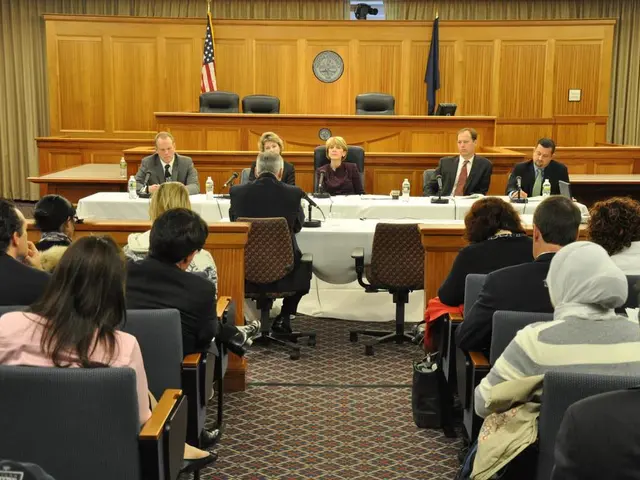Skydiving business in New Jersey claims that the pilot attempted an emergency landing, yet the plane veered off the runway, plunging into the woods instead.
In a tragic incident on July 2, 2025, a Cessna 208B Grand Caravan, a single-engine turboprop aircraft commonly used for skydiving operations, crashed at Cross Keys Airport in Williamstown, New Jersey. The accident occurred around 5:30 p.m., leaving 14 passengers and one crew member with injuries ranging from minor to critical.
The aircraft, owned by ARNE Aviation out of Virginia and leased to Skydive Cross Keys, was reportedly up-to-date on scheduled maintenance and had recently undergone an inspection by the Federal Aviation Administration (FAA). However, during ascent, the pilot encountered mechanical issues at an altitude of about 3,000 feet (900 meters), and the plane subsequently crashed while returning to the airport after a runway excursion into trees.
The crash resulted in the plane being "completely mangled, just beyond repair." The aircraft is currently involved in an ongoing investigation by federal agencies to determine the exact cause of the accident.
The Cessna 208B Grand Caravan is an extended version of the original Caravan, about four feet longer, typically seating up to 14 passengers but often configured for nine. It is powered by a Pratt & Whitney Canada PT6A-114A turboprop engine producing 675 shp. The Grand Caravan is popular for its versatility, including use as a skydiving platform, where the cargo door on the left side is often converted into a roll-up door for jumpers.
Passengers sustained injuries ranging from minor to critical, with 14 occupants transported to local hospitals. Three critically injured individuals were evacuated by helicopter, while five others remained seriously injured. As of Thursday afternoon, three men remained in critical condition at a New Jersey hospital.
Some passengers were contaminated with jet fuel at the scene and required decontamination before hospital transport. The skydiving plane's pilot was experienced, and none of the victims were taken to Inspira Medical Center Mullica Hill.
The investigation is ongoing, and the FAA has reported that the aircraft crashed while returning to the airport after a runway excursion into trees. The pilot's initial report of engine trouble suggests a mechanical or engine failure was a key factor, but a thorough investigation will be carried out by aviation authorities to determine the exact cause.
This incident serves as a grim reminder of the risks inherent in single-engine aircraft operations, especially under emergency conditions during takeoff with multiple passengers on board for skydiving activities. The ongoing investigation will provide more insights into technical or operational factors contributing to the accident.
- The incident involved a Cessna 208B Grand Caravan, a popular aircraft in the aerospace industry.
- ARNE Aviation, a company based in Virginia, owned the aircraft that was leased to Skydive Cross Keys.
- The Federal Aviation Administration (FAA) had recently inspected the aircraft before the accident.
- The aircraft encountered mechanical issues during ascent at an altitude of about 3,000 feet (900 meters).
- The Pratt & Whitney Canada PT6A-114A turboprop engine, which powers the Grand Caravan, produced 675 shp.
- The Grand Caravan is known for its versatility, including its use as a skydiving platform.
- Passengers involved in the accident were transported to local hospitals after sustaining injuries ranging from minor to critical.
- Three critically injured individuals were evacuated by helicopter, while five others remained seriously injured.
- As of Thursday afternoon, three men remained in critical condition at a New Jersey hospital.
- Some passengers were contaminated with jet fuel at the scene and required decontamination before hospital transport.
- The pilot was experienced, and none of the victims were taken to Inspira Medical Center Mullica Hill.
- The FAA has reported that the aircraft crashed while returning to the airport after a runway excursion into trees.
- The investigation will provide more insights into technical or operational factors contributing to the accident.
- This accident is a grim reminder of the risks in single-engine aircraft operations, especially during takeoff with multiple passengers for skydiving activities.
- The ongoing investigation will determine the exact cause of the accident, which may involve mechanical or engine failure.
- The insurance industry and wealth management firms will closely monitor the outcome of the investigation to assess potential risks.
- The incident has significant implications for the global aviation industry and its safety policies.
- In finance, there is increased concern about the potential impact on the industry's risk profile.
- Families of the passengers are left dealing with the emotional and financial fallout of the accident.
- The automotive industry, especially car-maintenance services, might see an increase in business due to the increased use of ground transport.
- Businesses in the lifestyle sector, such as outdoor-living and travel, might face challenges due to the negative publicity surrounding skydiving operations.
- Personal-finance advisors are now recommending careful consideration of family dynamics when making investment decisions.
- Investment in the food-and-drink sector, particularly businesses offering healthy-cooking recipes and global cuisines, may see growth as people seek healthy alternatives.
- In the real-estate market, there could be a shift in demand for properties located near hospitals and emergency services.
- Data-and-cloud-computing companies are expected to play a crucial role in analyzing the data from the accident to aid in the investigation.
- Sustainable-living and eco-friendly products might see a rise in popularity as people seek to minimize their carbon footprint, due to concerns about the environment and climate change.
- In the tech industry, advancements in electric vehicles and autonomous driving technologies could revolutionize the transportation sector, offering safer alternatives to single-engine aircraft.




